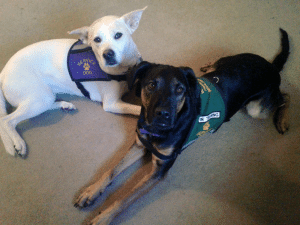 [by Navily Zhen] Stress reduction and relaxation techniques are important for dogs and people alike. When under stress, your body releases a hormone called cortisol. Cortisol has many important roles in regulating your body, such as controlling your sleep/wake cycle and boosting energy so you can handle stress. However, in both humans and dogs, too much or too little cortisol can lead to Cushing’s Syndrome or Addison’s Syndrome. With Cushing’s Syndrome, when the body produces too much cortisol, rapid weight gain, hair loss, and skin that bruises easily. However, too little cortisol results in Addison’s Syndrome, which leads to muscle weakness, lack of appetite, and depression, as the body cannot fight stressors properly.
[by Navily Zhen] Stress reduction and relaxation techniques are important for dogs and people alike. When under stress, your body releases a hormone called cortisol. Cortisol has many important roles in regulating your body, such as controlling your sleep/wake cycle and boosting energy so you can handle stress. However, in both humans and dogs, too much or too little cortisol can lead to Cushing’s Syndrome or Addison’s Syndrome. With Cushing’s Syndrome, when the body produces too much cortisol, rapid weight gain, hair loss, and skin that bruises easily. However, too little cortisol results in Addison’s Syndrome, which leads to muscle weakness, lack of appetite, and depression, as the body cannot fight stressors properly.
What causes stress in dogs? For humans, stress comes from emotional issues, traumatic events, illnesses or injuries, and much more. But for dogs, stress can be caused by memory loss that comes from aging, various fears, and separation to name a few.
As the mission of Healing Companions is to assist individuals, psychiatric service dogs are trained to guide a client disoriented by anxiety. Our Executive Director, Jane Miller, has taught stress reduction and relaxation techniques that were able to help not only dogs but their handlers as well. Ms. Miller has found that learning to monitor a dog’s breathing has helped the handlers breathe differently, reducing their anxiety levels at the same time. To monitor your dog’s breathing:
-
- Wait until your pet is sleeping soundly (i.e. not dreaming), and not panting or purring.
- Count the number of times the chest rises and falls (1 full rise and fall equals 1 breath) over 60 seconds.
- Do this at least once a day for 7 days, and record your pet’s resting respiratory rate on your calendar.
Similarly, as physical activities allow for humans to de-stress, dogs can cope with stressors the same way by playing fetch, shaking it off or walking with their handler. Other techniques that can be beneficial to both humans and dogs include breathing relaxation techniques the dog and human do together, yoga, listening to classic, relaxing music, and massages, acupressure points, and the TTouch technique for dogs, which is encouraged by Ms. Miller in the slideshow linked below.
Dogs have issues too, and it is important for handlers to maintain their own wellness along with their pet’s.
More Stress Reduction Techniques can be found here (extremely informative): https://e-trainingfordogs.com/helping-dogs-cope-with-stress/
An informative video on acupressure points: https://youtu.be/M2RJrGTpBgk
Citations
https://www.webmd.com/a-to-z-guides/what-is-cortisol#1
https://vcahospitals.com/know-your-pet/signs-your-dog-is-stressed-and-how-to-relieve-it
https://www.fitbark.com/blog/the-top-10-tips-for-relieving-your-dogs-stress/
https://www.akc.org/expert-advice/health/treating-dog-anxiety/

Leave a Reply